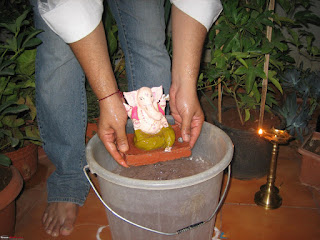The culmination
of the Ganesh Chaturthi festival is with the most important Ganesh
immersion ceremony or Ganesh Visarjan. In 2012, it is on September 29.
When to immerse the Ganesh idol? Or when is the Ganesh immersion day?
This is a perplexing question for many. Normally, Ganesh Visarjan takes
place on Ananta Chaturdashi day. But there are no hard and fast rules
for Ganesh Immersion, it usually depends on family tradition.
2012 Dates of Lord Ganesha immersion
One day – September 20
Three days – September 21
Five Days – September 23
Seven – September 25
Ten days – September 28
Ananta Chaturdashi last day– September 29
Why Ganesh Idols Immersed in Water at the End of the Festival?
Hindus worship
idols, of their gods because it gives them a visible form to pray to.
They also recognize that the universe is in a constant state of change.
Form eventually gives away to formlessness. However, the energy still
remains. The immersion of the statues in the ocean, or other bodies of
water, and subsequent destruction of them serves as a reminder of this
belief.Some families perform the ceremony on the very next day. It is
believed that Ganesha comes and stays in the idol for a day and returns
the next day.There are other families which perform the Ganesh immersion or Visarjan on the 1.5 days, 3rd, 5th, 7th or the 10th day.
Today, many people choose the least crowded day to immerse the Ganesh idol. Those
who opt for an eco-friendly Ganesh immersion, do it in a bucket or a
tank. In Mumbai, artificial lakes are created to avoid water pollution.
This year the governments and NGOs are running a strong campaign for the
use of eco-friendly Ganesh idols.
Environmental pollution caused by Ganesh Chaturthi festival
Widespread
campaigns are already on for an eco-friendly Ganesh Chaturthi festival
but still a large section of the society are unaware of the pollution
and environmental damage caused by Plaster of Paris idols and chemical
paints. Some large Ganesha Pandal committees, to attract maximum crowd
conveniently forget the environmental impact caused by the idols. The
main pollution is caused by the Plaster of Paris Ganesh idols and the
chemical paints used in them.
Plaster of
Paris (POP) is not a naturally occurring material and contains gypsum,
sulphur, phosphorus and magnesium. The idols take several months to
dissolve in water and in the process poison the waters of lake, ponds,
rives and seas.
The chemical
paints used to decorate the Ganesh idol contain mercury, lead, cadmium
and carbon and this increases the acidity and heavy metal content in the
water.Several accessories used during the Ganesh Puja like Thermocole,
plastic flowers, cloth, incense, camphor and numerous other materials
are dumped carelessly adding more strain to the already polluted rivers
and lakes.
Careless
dumping of Ganesh idols in waterbodies blocks the natural flow of water.
This results in stagnation and breeding of mosquitoes and other harmful
pests.The polluted water causes several diseases including skin
diseases.The pollution from Ganesh Chaturthi idols also damages the
ecosystem, kills fishes and water plants.In many areas, the same
polluted water gets pumped into homes.
Alternatives
Use eco-friendly clay idols painted with natural colors.
Use permanent idols made of stone and perform a symbolic immersion and reuse the idol each year.
Avoid public waterbodies to immerse the idols, instead immerse idol in bucket or tub.
Author:


No comments:
Post a Comment
Thank you,
- Hinduadhyathmikam.